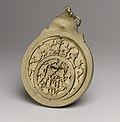Brass
Brass is an alloy of copper and zinc. Some types of brass are called bronzes.
Brass has a golden appearance. It is harder than pure metals and resists corrosion. It costs more than zinc.
There are some common brasses:
- Alpha brasses - with less than 40% zinc
- Beta brasses -
- White brasses - with more than 45% zinc
Things brass are used to make include:
Properties
Brass is more malleable than bronze or zinc. The melting point of brass can be 900 to 940 °C or 1,650 to 1,720 °F, depending on what it is made of. The density of brass is 8.4 to 8.73 g/cm3 (0.303 to 0.315 lb/cu in).[1]
Today, almost 90% of all brass alloys are recycled. Brass is not ferromagnetic. Brass scrap is collected and transported to the foundry. In the foundry, it is melted and recast into billets. The billets are heated and stretched into the form and size that is wanted.[2]
Brass will corrode when it is exposed to moisture, chlorides, acetates, ammonia, and some acids.
Brass alloys
There are many brass alloys. They include:
- Abyssinian gold
- Admiralty brass
- Aich's alloy
- Aluminum brass
- Arsenical brass
- Cartridge brass
- Common brass
- DZR brass
- Delta metal
- Free machining brass
- Gilding metal
- High brass
- Leaded brass
- Lead-free brass
- Low brass
- Manganese brass
- Muntz metal
- Naval brass
- Nickel brass
- Nordic gold
- Orichalcum
- Prince's metal
- Red brass
- Tombac
- Silicon tombac
- Tonval brass
- Yellow brass
Brass Media
Islamic Golden Age brass astrolabe
Brass lectern with an eagle. Attributed to Aert van Tricht, Limburg (Netherlands), c. 1500.
Microstructure of rolled and annealed brass (400× magnification)
Cracking in brass caused by ammonia attack
7th-century Persian ewer in brass with copper inlay, Walters Art Museum, Baltimore, Maryland, US
Baptism of Christ on the 12th-century baptismal font at St Bartholomew's Church, Liège
Brass aquamanile from Lower Saxony, Germany, c. 1250
References
- ↑ "Mass, Weight, Density or Specific Gravity of Different Metals". www.simetric.co.uk. Retrieved 2020-10-21.
- ↑ Camm, Frederick James (1949). Newnes Engineer's Reference Book. George Newnes.









